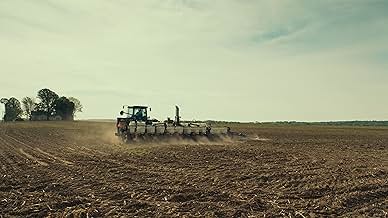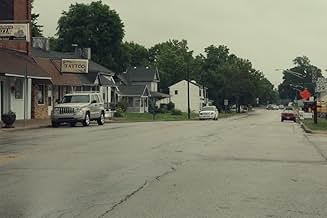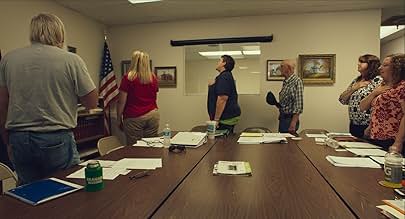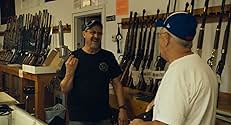Füge eine Handlung in deiner Sprache hinzuFollowing the 2016 presidential election, Frederick Wiseman's documentary dissects small-town America to understand how its values impact and influence the political landscape of the nation.Following the 2016 presidential election, Frederick Wiseman's documentary dissects small-town America to understand how its values impact and influence the political landscape of the nation.Following the 2016 presidential election, Frederick Wiseman's documentary dissects small-town America to understand how its values impact and influence the political landscape of the nation.
- Regie
- Auszeichnungen
- 1 Gewinn & 4 Nominierungen insgesamt
Empfohlene Bewertungen
The film Monrovia Indiana is a truly remarkable achievement in that just when you think it cannot possible go on any longer, it just keeps going, much like the Great Crossroads itself. This is a shame.
Contrast with Hale County. That film too turned the camera on an overlooked slice of America, and yet it transcended the typical narrative to reveal something more, something unexpected. A conversation with a man burning leaves turned into the sublime. It provided space for you to think and reflect. Mr. Weisman on the other hand seems to believe that shots of coke in the supermarket are quite subversive, and that it is dreadfully important that viewers experience a full length Masonic ceremony, stumbling and stammering and all. Even Gopher Prairie is a more flattering portrait of small town America than this.
Oh and here's a shot of a field. Wow that sure is a field! And oh here's a shot of a building. That's sure some building there! It all literally looks like google street view.
And oh and now they've been talking about a bench for five minutes. And now a dog is getting its tail amputated for who knows why. And now we are at the mattress store. And now we're in church. Just kill me now.
I refuse to believe that America can possibly be as dull, as small, and as ugly as it is presented as here. There is no profound insight in debating a bench! There is nothing to reveal in a mattress warranty! This is not art but a caricature that has the gall to try passing itself off as an auteur's quietly documentary of real America.
In short: this is a film we've all seen before and do not ever need to see again. It's amazingly boring both visually and narratively, and conceptually bankrupt. The best that can be said of this self indulgent mess is that it quickly and unknowingly descends into self parody.
Contrast with Hale County. That film too turned the camera on an overlooked slice of America, and yet it transcended the typical narrative to reveal something more, something unexpected. A conversation with a man burning leaves turned into the sublime. It provided space for you to think and reflect. Mr. Weisman on the other hand seems to believe that shots of coke in the supermarket are quite subversive, and that it is dreadfully important that viewers experience a full length Masonic ceremony, stumbling and stammering and all. Even Gopher Prairie is a more flattering portrait of small town America than this.
Oh and here's a shot of a field. Wow that sure is a field! And oh here's a shot of a building. That's sure some building there! It all literally looks like google street view.
And oh and now they've been talking about a bench for five minutes. And now a dog is getting its tail amputated for who knows why. And now we are at the mattress store. And now we're in church. Just kill me now.
I refuse to believe that America can possibly be as dull, as small, and as ugly as it is presented as here. There is no profound insight in debating a bench! There is nothing to reveal in a mattress warranty! This is not art but a caricature that has the gall to try passing itself off as an auteur's quietly documentary of real America.
In short: this is a film we've all seen before and do not ever need to see again. It's amazingly boring both visually and narratively, and conceptually bankrupt. The best that can be said of this self indulgent mess is that it quickly and unknowingly descends into self parody.
The director captured the essence of Indiana small-town life perfectly in this PBS documentary. The citizens of Monrovia are exactly the same personality types that I met during my time in rural Indiana about 40 years ago. It appears that nothing has changed.
I lived in Clayton, Indiana for about 4 years. Clayton is very close to Monrovia, which had the only bank in the area. I came from the Seattle, WA area, so the whole culture and landscape of Clayton and Monrovia were foreign to me - the flat fields as far as the eye could see and beyond. The social life of people in these farm areas is very structured and life experiences are limited by the narrow perspective of a strictly proscribed culture. I ended up in Indiana because my husband and I wanted to established a thoroughbred stud farm and his parents had a large parcel of land. When we got there and realized what a different landscape and social structure we found ourselves, I regretted moving there almost immediately. I was in a strange place and I had a lot to learn about middle America culture. People knew that I was not local. Not just from my (non-Southern) accent, but from my questions about (1) the religious emphasis in daily life, l(2) seeming lack of interest in local or national government, and (3) attitudes about women and their "place" in society.
After returning to the Pacific Northwest after 4 years and Iooking back on my experiences in Clayton and Monrovia, I had a better idea about how people in different parts of America think about life and society in general. Where we live molds our perspective through exposure to different people and different landscapes.
I lived in Clayton, Indiana for about 4 years. Clayton is very close to Monrovia, which had the only bank in the area. I came from the Seattle, WA area, so the whole culture and landscape of Clayton and Monrovia were foreign to me - the flat fields as far as the eye could see and beyond. The social life of people in these farm areas is very structured and life experiences are limited by the narrow perspective of a strictly proscribed culture. I ended up in Indiana because my husband and I wanted to established a thoroughbred stud farm and his parents had a large parcel of land. When we got there and realized what a different landscape and social structure we found ourselves, I regretted moving there almost immediately. I was in a strange place and I had a lot to learn about middle America culture. People knew that I was not local. Not just from my (non-Southern) accent, but from my questions about (1) the religious emphasis in daily life, l(2) seeming lack of interest in local or national government, and (3) attitudes about women and their "place" in society.
After returning to the Pacific Northwest after 4 years and Iooking back on my experiences in Clayton and Monrovia, I had a better idea about how people in different parts of America think about life and society in general. Where we live molds our perspective through exposure to different people and different landscapes.
This is not one of Wiseman's best films. Many people complain about how long it is and that it feels like it's going nowhere. Well, the 2nd part is correct. The film is somewhat long (143 minutes), but most of Wiseman's films run between 3-4 hours, and a few of them go longer than that. City Hall is 4 1/2 hours, and Near Death is 6 hours. This is a relatively short one. The issue is that the film feels too short, and Wiseman, uncharacteristically, cuts around too much and doesn't let his camera run on the people on the town. Part of Wiseman's genius is that he captures fascinating parts of reality in his movies, but they are often extended and some scenes run up to 20 minutes in length. Despite these extended scenes, his films are never boring and I love almost everything I've seen by him. However, in Monrovia, Indiana, he doesn't do that. He just jumps around randomly to people and events without any flow to it. It's almost like he wasn't that interested in these people, and most of the people in the film appear merely once in the picture. In his other pictures, the subjects often appear throughout the film and the films flow better. The one time Wiseman lets a scene play out is at the end when a local woman passes away. That scene runs 20 minutes or so and is the best scene in the film.
We never really get to know the town too much because of the overly episodic nature of the film and that Wiseman never bothers to get to know the people that well. One of the few disappointments from Wiseman.
We never really get to know the town too much because of the overly episodic nature of the film and that Wiseman never bothers to get to know the people that well. One of the few disappointments from Wiseman.
Here's an inside look at the workings of a town in the U. S. heartland. We see the people of Monrovia at their feedlots, corn fields, municipal hearings, schools and places of worship - a great panorama of life in this good place. Some Midwestern stereotypes are knocked down here, not on purpose but as revealed by the responsible way these people act. As a viewer I thank the people of Monrovia - and it's an impressive cross-section of people - for granting access to so much of what matters in this community. There is a bit of self-deprecation, people of Monrovia acknowledging they live in a small town. But in fact it's a big place, in civic spirit and caring for others.
Very weird seeing a documentary about a small town 15 minutes from where I live, and that I've spent a decent chunk of time in. Seeing it from an outsider's perspective was different, and seeing all of these roads I've driven on through a camera lens was an odd experience. Honestly surprised the director found enough content in Monrovia to make an almost two and a half hour movie out of, considering I can drive across town in twenty seconds. Still cool, though, never knew this documentary existed. I always like documentaries that show an unfiltered glimpse into the life of others, and this was no different, even though the life it showed was basically the same as the one I live.
Wusstest du schon
- WissenswertesShot in ten weeks.
Top-Auswahl
Melde dich zum Bewerten an und greife auf die Watchlist für personalisierte Empfehlungen zu.
Details
Box Office
- Bruttoertrag in den USA und Kanada
- 63.944 $
- Eröffnungswochenende in den USA und in Kanada
- 5.172 $
- 28. Okt. 2018
- Weltweiter Bruttoertrag
- 64.596 $
- Laufzeit
- 2 Std. 23 Min.(143 min)
- Farbe
- Seitenverhältnis
- 1.85 : 1
Zu dieser Seite beitragen
Bearbeitung vorschlagen oder fehlenden Inhalt hinzufügen





















